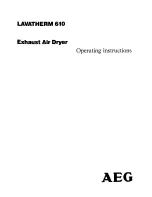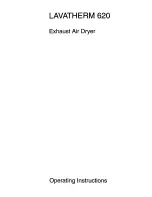
41
INFORMATION ON SERVICING
Check to the area
Prior to beginning work on systems containing flammable refrigerants, safety checks are necessary to
ensure that the risk of ignition is minimised. For repair to the refrigerating system, the following precau-
tions shall be complied with prior to conducting work on the system.
Work procedure
Work shall be undertaken under a controlled procedure as to minimise the risk of a flammable gas or
vapour being present while the work is being performed.
General work area
All maintenance staff and others working in the local area shall be instructed on the nature of work being
carried out. Work in confined spaces shall be avoided. The area around the workspace shall be sectioned
off. Ensure that the conditions within the area have been made safe by control of flammable material.
Checking for presence of refrigerant
The area shall be checked with an appropriate refrigerant detector prior to and during work, to ensure
the technician is aware of potentially flammable atmospheres. Ensure that the leak detection equipment
being used is suitable for use with flammable refrigerants, i.e. non-sparking, adequately sealed or intrin-
sically safe.
Presence of fire extinguisher
If any hot work is to be conducted on the refrigeration equipment or any associated parts, appropriate fire
extinguishing equipment shall be available to hand. Have a dry powder or C02 fire extinguisher adjacent
to the charging area.
No ignition sources
No person carrying out work in relation to a refrigeration system which involves exposing any pipe work
that contains or has contained flammable refrigerant shall use any sources of ignition in such a manner
that it may lead to the risk of fire or explosion. All possible ignition sources, including cigarette smoking,
should be kept sufficiently far away from the site of installation, repairing, removing and disposal, during
which flammable refrigerant can possibly be released to the surrounding space. Prior to work taking
place, the area around the equipment is to be surveyed to make sure that there are no flammable haz-
ards or ignition risks. ”No Smoking” signs shall be displayed.
Ventilated area
Ensure that the area is in the open or that it is adequately ventilated before breaking into the system or
conducting any hot work. A degree of ventilation shall continue during the period that the work is carried
out. The ventilation should safely disperse any released refrigerant and preferably expel it externally into
the atmosphere.
Summary of Contents for DH5020
Page 2: ...1 4 7 5 6 2 3...
Page 3: ...9 8 15 10 21 11 12 13 19 18 17 14 16 10 20 Humidity setting Humidity setting...
Page 62: ...62 UFESA 8 30 cm...
Page 63: ...63 20 cm T F 250V 3 15 4 m2 R290 60g...
Page 64: ...64...
Page 65: ...65 0 C...
Page 66: ...66 B B TRENDS SL 1 2 3 4 5 6 7 8 9 10 11 12 13 14 15 16 17 18 19 20 21 1...
Page 67: ...67 50 50 70 70 3 0 24 30 80 14 0 24 0 24...
Page 68: ...68 3...
Page 69: ...69 2 30 0 C 10 C 30...
Page 70: ...70 2 4...
Page 71: ...71 Le volume d...
Page 72: ...72 2012 19 C02...
Page 73: ...73...
Page 74: ...74...
Page 75: ...75 25...
Page 76: ...76...
Page 77: ...77 a b c d e f g h 80 i...
Page 78: ...78 j k...
Page 79: ...79...
Page 80: ...80 2 4 06 092R...
Page 81: ...81 UFESA 8 30 20 250 F T 3 15...
Page 83: ...83 0 B B TRENDS SL 1 2 3 4 5 6 7 8 9 10 11 12 13 14 15 16 17 18 19 20 21...
Page 84: ...84 30 ON OFF 2 4...
Page 85: ...85 ON OFF Continuous mode mode mode 3 2 0 30 10...
Page 86: ...86 C02...
Page 87: ...87 WEEE EU 91 2102...
Page 89: ...89 25...
Page 90: ...90...
Page 91: ...91 08...
Page 94: ...94 B B TRENDS SL e B B TRENDS SL 1999 44 B B TRENDS SL B B TRENDS SL...
Page 95: ...95 B B TRENDS SL 23 2003 B B TRENDS SL 2003 10 B B TRENDS SL...
















































